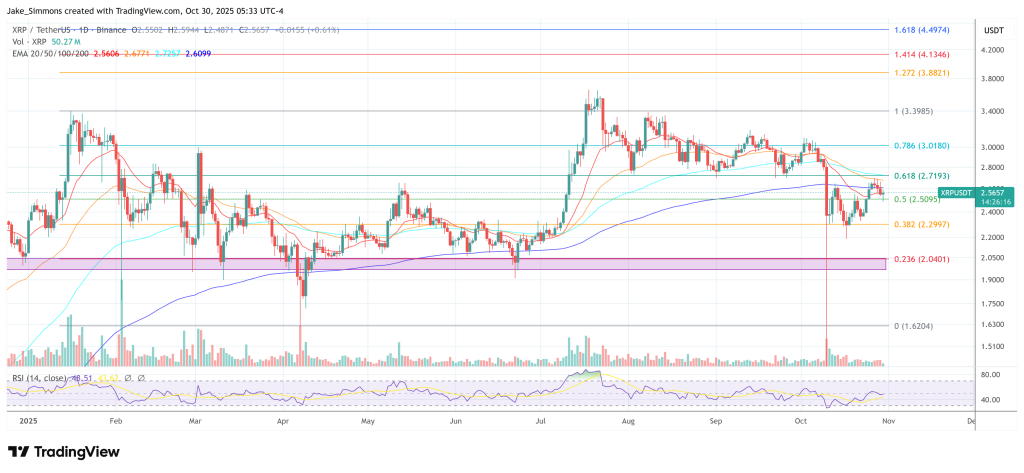The long-running dispute over what XRP is actually for — not Ripple’s business model, but the token itself — exploded again on October 30, 2025, after crypto expert Scott Melker publicly asked whether the asset still has a live, defensible use case in an ecosystem now dominated by fiat-backed stablecoins.
What Is The Utility Of XRP?
“I say this with no disrespect, looking for an actual answer,” Melker wrote on X. “What is the current pitch for XRP? The token, not Ripple the company.” He pointed to concrete developments in cross-border settlement rails: “Western Union chose Solana for their stablecoin. Swift went with Linea on ETH, which was the selling point I heard for years?” Melker then set the tone for the entire debate: “Stablecoins have clearly taken the reigns for payments, so I get their stablecoin being in play. But what utility does XRP have? Again, not trolling. Asking.” The post had more than 291,000 views on October 30.
The first major response came from community members who argued that the comparison to stablecoins is structurally wrong. The account Cripto ISO 22 said the token is not meant to compete with bank-grade or treasury-grade stablecoins. Instead, as they put it, “XRP is not competing with stablecoins it’s the liquidity bridge between them and between currencies, assets, and payment networks. While stablecoins represent value, XRP represents mobility.”
According to that view, the token exists to provide “real-time settlement, FX conversion, and on-demand liquidity between CBDCs, banks, and corporate treasuries.” Ripple’s buildout — including GTreasury, RLUSD, and Evernorth — is framed as an emerging infrastructure layer in which the token becomes “the neutral asset connecting all forms of money. Stablecoins move within silos. XRP moves value across them.”
Melker challenged that logic directly. “This makes no sense to me, perhaps I’m dense,” he replied. “You can use a stablecoin as the bridge for conversions with zero loss from token volatility. Why is the token needed specifically and not another?” He later said he was still looking for something verifiable now rather than projections: “I think the core issue I have is that people are screaming at me about all of the things that ‘will’ happen but nobody can tell me what ‘is’ happening. Meanwhile, Stablecoins are eating the world.”
Ripple’s Dependence
Former CoinRoutes chairman Dave Weisberger stepped in and accused large parts of the community of refusing to confront basic balance-sheet realities. “People buy XRP because it’s a meme,” he said. “Just like ADA. Just like Doge. Just like Trump coin. It’s never been about the utility. It’s about the XRP community which is one of the strongest to this day.” Weisberger said that when he has asked the same question Melker is now asking, “the ONLY coherent answer I’ve gotten is Ripple is making XRP ‘central’ to their strategy. Translation: their Prime needs an enormous balance sheet & XRP makes up the majority of it, for now…”
He then drew a direct line between market price and Ripple’s operational runway. “XRP doesn’t need to go UP for that plan to work, but it can’t crash without causing pain as they need the balance sheet.” He closed with the line that defined the tone of the thread: “Make of that what you will, but the delusions of 100x returns are blinding you from real analysis…”
Weisberger’s stance is that the token’s current relevance is not the result of unstoppable external adoption, but of Ripple structurally depending on the token as collateral and liquidity inside its own stack. That argument implicitly rejects the long-standing claim that “Ripple and XRP are separate,” suggesting instead that the token is deeply tied to Ripple’s balance sheet and Prime liquidity strategy. If XRP’s price holds, Ripple can deploy it. If price collapses, Ripple’s firepower weakens.
The XRP camp answered from first principles. The account @xrpmickle argued that even asking for a “pitch” misunderstands what the token is. “The value proposition isn’t a temporary pitch — it’s foundational,” he wrote. “[The token] serves the same core purpose that many of the top cryptocurrencies do: it’s the native form of value and security layer for the distributed ledger it operates on. […] The XRP Ledger literally cannot exist or operate without XRP.”
Mickle went further, arguing that stablecoins are issued liabilities whose usefulness is inherited from the network they sit on, whereas the token is “integral — not derived.” In that telling, the token is designed to be neutral settlement-grade liquidity that can connect incompatible systems, not a bank IOU that lives inside a corporate silo.
Melker, however, drew a line between what the token is architected to be and what it is currently doing at institutional scale. “Nobody can tell me what ‘is’ happening,” he wrote, pointing to what he sees as a gap between forward-looking claims and visible corridors today. That same split surfaced in a side exchange about Bitcoin, where a critic asked what Bitcoin is “actually used for.” Melker responded: “That’s kind of the point. It doesn’t need to be used for anything.” In other words, Bitcoin can be defended as monetary premium. XRP, by contrast, is marketed as transactional infrastructure, so it lives or dies on being used.
At press time, XRP traded at $2.56.
